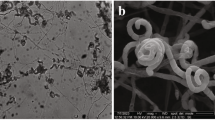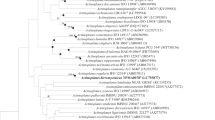Abstract
An actinomycete, designated strain CH9-7T, was isolated from the rhizosphere soil of Mangifera indica. The morphological and chemotaxonomic properties, such as the production of spiral spore chains and the presence of LL-diaminopimelic acid in the peptidoglycan, showed that it belongs to the genus Streptomyces. Based on the 16S rRNA gene analysis, it was confirmed that strain CH9-7T was a member of the genus Streptomyces and revealed 99.9% 16S rRNA gene sequence similarity to its closest relative strains, Streptomyces lydicus NBRC 13058 T and Streptomyces chattanoogensis NBRC 12754 T. Although the strain showed high 16S rRNA gene sequence similarity values, however, genome relatedness indexes exhibited that the average nucleotide identity based on the MUMmer (ANIm) algorithm, the average amino acid identity (AAI), and the digital DNA–DNA hybridization values between strain CH9-7T and its closest phylogenomic relatives were below the threshold values for delineation of a novel species, (ANIm ranging from 87.5 to 88.6, AAI ranging from 80.6 to 84.6, and dDDH ranging from 28.4 to 31.7), respectively. A taxonomic position of strain CH9-7T in the phylogenomic tree showed that the closest relative strain was S. lydicus NBRC 13058 T. The comparative phenotypic studies between strain CH9-7T and its closest relatives revealed that strain CH9-7T could be classified as a novel species of the genus Streptomyces. Thus, the name Streptomyces siderophoricus sp. nov. is proposed for the strain. The type strain is CH9-7T ( = TBRC 17833 T = NBRC 116426 T). The chemical investigation led to the isolation of four known compounds (compounds 1-4). Among these compounds, compound 1 was identified to be nocardamine, a promising bioactive substance.
This is a preview of subscription content, access via your institution
Access options
Subscribe to this journal
Receive 12 print issues and online access
$259.00 per year
only $21.58 per issue
Buy this article
- Purchase on Springer Link
- Instant access to full article PDF
Prices may be subject to local taxes which are calculated during checkout



Similar content being viewed by others
References
Bérdy J. Bioactive microbial metabolites. J Antibiot. 2005;58:1–26.
Parte AC, Sardà Carbasse J, Meier-Kolthoff JP, Reimer LC, Göker M. List of Prokaryotic names with Standing in Nomenclature (LPSN) moves to the DSMZ. Int J Syst Evol Microbiol. 2020;70:5607–12.
Kämpfer P. The Actinobacteria. In: Goodfellow M, et al. editors. Bergey’s Manual of Systematic Bacteriology. 2nd ed. New York: Springer; 2012. pp 1455–767.
Wang W, Qiu Z, Tan H, Cao L. Siderophore production by actinobacteria. Biometals. 2014;27:623–31.
Miethke M, Marahiel MA. Siderophore-based iron acquisition and pathogen control. Microbiol Mol Biol Rev. 2007;71:413–51.
Kalinovskaya NI, Romanenko LA, Irisawa T, Ermakova SP, Kalinovsky AI. Marine isolate Citricoccus sp. KMM 3890 as a source of a cyclic siderophore nocardamine with antitumor activity. Microbiol Res. 2011;166:654–61.
Cao L, Qiu Z, You J, Tan H, Zhou S. Isolation and characterization of endophytic streptomycete antagonists of fusarium wilt pathogen from surface-sterilized banana roots. FEMS Microbiol Lett. 2005;247:147–52.
Tokala RK, Strap JL, Jung CM, Crawford DL, Salove MH, Deobald LA, et al. Novel plant microbe rhizosphere interaction involving Streptomyces lydicus WYEC108 and the pea plant (Pisum sativum). Appl Environ Microbiol. 2002;68:2161–71.
Duangupama T, Pratuangdejkul J, Chongruchiroj S, Pittayakhajonwut P, Intaraudom C, Tadtong S, et al. New insights into the neuroprotective and beta-secretase1 inhibitor profles of tirandamycin B isolated from a newly found Streptomyces composti sp. nov. Sci Rep. 2023;13:4825.
Thawai C, Rungjindamai N, Klanbut K, Tanasupawat S. Nocardia xestospongiae sp. nov., isolated from a marine sponge in the Andaman Sea. Int J Syst Evol Microbiol. 2017;67:1451–56.
Shirling EB, Gottlieb D. Methods for characterization of Streptomyces species. Int J Syst Bacteriol. 1966;16:313–40.
Duangupama T, Pansomsuay R, Pittayakhajonwut P, Intaraudom C, Suriyachadkun C, He Y-W, Tanasupawat S, Thawai C. Micromonospora solifontis sp. nov., an actinobacterium isolated from hot spring soil. Int J Syst Evol Microbiol. 2023;73:005819.
Kelly KL. Inter-Society Color Council – National Bureau of Standard Color Name Charts Illustrated with Centroid Colors. Washington DC: US Government Printing Office; 1964.
Arai T, Tamotsu F, Masa H, Akihiro M, Yuzuru M. Culture media for actinomycetes. Tokyo: The Society for Actinomycetes Japan. 1975; 1–20.
Williams ST. Cross T Actinomycetes. In: Booth C, editor. Methods in Microbiology. Academic Press, London; 1971. pp. 295–334.
Gordon RE, Barnett DA, Handerhan JE, Pang CHN. Nocardia coeliaca, Nocardia autotrophica, and the nocardia strain. Int J Syst Bacteriol. 1974;24:54–63.
Supong K, Suriyachadkun C, Pittayakhajonwut P, Suwanborirux K, Thawai C. Micromonospora spongicola sp. nov., an actinomycete isolated from a marine sponge in the Gulf of Thailand. J Antibiot. 2013;66:505–09.
Thawai C, Tanasupawat S, Kudo T. Actinaurispora gen. nov., a new member of the family Micromonosporaceae, with description of Actinaurispora siamensis sp. nov. Int J Syst Evol Microbiol. 2010;60:1660–66.
Hasegawa T, Takizawa M, Tanida S. A rapid analysis for chemical grouping of aerobic actinomycetes. J Gen Appl Microbiol. 1983;29:319–22.
Komagata K, Suzuki KI. Lipid and cell-wall analysis in bacterial systematics. Methods Microbiol. 1987;19:161–207.
Minnikin DE, Patel PV, Alshamaony L, Goodfellow M. Polar lipid composition in the classification of Nocardia and related bacteria. Int J Syst Evol Microbiol. 1977;27:104–17.
Sasser M. Identification of bacteria by gas chromatography of cellular fatty acids. MIDI Technical Note. 101. Newark: Microbial ID Inc; 1990.
Kämpfer P, Kroppenstedt RM. Numerical analysis of fatty acid patterns of coryneform bacteria and related taxa. Can J Microbiol. 1996;42:989–1005.
Collins MD, Pirouz T, Goodfellow M, Minnikin DE. Distribution of menaquinones in actinomycetes and corynebacteria. J Gen Microbiol. 1977;100:221–30.
Tamaoka J. Determination of DNA base composition. In: Goodfellow, M, O’Donnell, AG, editors. Chemical methods in prokaryotic systematics. New York: Chichester, John Wiley & Sons. 1994. p. 463–70.
Kittiwongwattana C, Thanaboripat D, Laosinwattana C, Koohakan P, Parinthawong N, Thawai C. Micromonospora oryzae sp. nov., isolated from roots of upland rice. Int J Syst Evol Microbiol. 2015;65:3818–23.
Yoon SH, Ha SM, Kwon S, Lim J, Kim Y, Seo H, et al. Introducing EzBioCloud: a taxonomically united database of 16S rRNA and whole-genome assemblies. Int J Syst Evol Microbiol. 2017;67:1613–17.
Saitou N, Nei M. The neighbor-joining method: a new method for reconstructing phylogenetic trees. Mol Biol Evol. 1987;4:406–25.
Fitch WM. Toward defining the course of evolution: minimum change for a species tree topology. Sys Zoo. 1971;20:406–16.
Felsenstein J. Evolutionary trees from DNA sequences: a maximum likelihood approach. J Mol Evol. 1981;17:368–76.
Kumar S, Stecher G, Li M, Knyaz C, Tamura K. MEGA X: molecular evolutionary genetics analysis across computing platforms. Mol Biol Evol. 2018;35:1547–49.
Felsenstein J. Confidence limits on phylogenies: an approach using the bootstrap. Evolution. 1985;39:783–91.
Wattam AR, Davis JJ, Assaf R, Boisvert S, Brettin T, Bun C, et al. Improvements to PATRIC, the all-bacterial bioinformatics database and analysis resource center. Nucleic Acids Res. 2017;45:D535–42.
Richter M, Rosselló-Móra R, Glöckner FO, Peplies J. JSpeciesWS: a web server for prokaryotic species circumscription based on pairwise genome comparison. Bioinform. 2016;32:929–31.
Rodriguez-R LM, Konstantinidis KT. Bypassing cultivation to identify bacterial species. Micro Mag. 2014;9:111–18.
Meier-Kolthoff JP, Auch AF, Klenk HP, Göker M. Genome sequence-based species delimitation with confidence intervals and improved distance functions. BMC Bioinform. 2013;14:60–73.
Alanjary M, Steinke K, Ziemert N. AutoMLST: an automated web server for generating multi-locus species trees highlighting natural product potential. Nucleic Acids Res. 2019;47:276–82.
Kämpfer P. Genus Streptomyces. In: Goodfellow M, Kämpfer P, Busse HJ, Trujillo ME, Suzuki KI, Ludwig W et al. editors. Bergey’s manual of systematic bacteriology, 2nd ed. New York: Springer. 2012. p.1455–1767.
Duangupama T, Pittayakhajonwut P, Intaraudom C, Tadtong S, Thawai C. Streptomyces epipremni sp. nov., an endophytic actinomycete isolated from the root of Epipremnum aureum. Int J Syst Evol Microbiol. 2022;72:005179.
Stackebrandt E, Ebers J. Taxonomic parameters revisited: tarnished gold standards. Microbiol Today. 2006;33:152–5.
Hu S, Li K, Zhang Y, Wang Y, Fu L, Xiao Y, et al. New insights into the threshold values of multi-locus sequence analysis, average nucleotide identity and digital DNA–DNA hybridization in delineating Streptomyces species. Front Microbiol. 2022;13:910277.
Richter M, Rossello-Mora R. Shifting the genomic gold standard for the prokaryotic species definition. Proc Natl Acad Sci USA. 2009;106:19126–31.
Goris J, Konstantinidis KT, Klappenbach JA, Coenye T, Vandamme P, Tiedje JM. DNA-DNA hybridization values and their relationship to whole-genome sequence similarities. Int J Syst Evol Microbiol. 2007;57:81–91.
Maehr H, Benz W, Smallheer J, Williams TH. Mikrobielle Produkte, I NMR-Spektren von Nocardamin und Massenspektrum des Tri-O-methyl-nocardamins / Microbiological Products, I NMR Spectra of Nocardamine and Mass Spectra of Tri-O-methyl-nocardamine. Z Naturforsch B. 1977;32:937–42.
Kim YP, Takamatsu S, Hayashi M, Komiyama K, Omura S. Pyridindolols K1 and K2, new alkaloids from Streptomyces sp. K93-0711. J Antibiot. 1997;50:189–93.
Dillman RL, Cardellina JH. Aromatic secondary metabolites from the sponge Tedania ignis. J Nat Prod. 1991;54:1056–61.
Keller-Schierlein W, Müller A, Hagmann L, Schneider U, Zähner H. Stoffwechselprodukte von Mikroorganismen. 232. Mitteilung. (E)-3-(1H-Pyrrol-3-yl)-2-propensäure und (E)-3-(1H-Pyrrol-3-yl)-2-propensäureamid aus Streptomyces parvulus, Stamm Tü 2480. Helv Chim Acta. 1985;68:559–62.
Stoll A, Brack A, Renz J. Nocardamin, ein neues Antibioticum aus einer Nocardia-Art: (9. Mitteilung über antibakterielle Stoffe). Schweiz Z Pathol Bacteriol. 1951;14:225–33.
Lee H-S, Shin HJ, Jang KH, Kim TS, Oh K-B, Shin J. Cyclic peptides of the nocardamine class from a marine-derived bacterium of the genus Streptomyces. J Nat Prod. 2005;68:623–25.
Aoyagi T, Kumagai M, Hazato T, Hamada M, Takeuchi T. Pyridindolol, a new beta-galactosidase inhibitor produced by actinomycetes. J Antibiot. 1975;28:555–57.
Hagmann L, Keller-Schierlein W, Wahl B, Zähner H. Metabolites of microorganisms pyridindolol glucosides from Streptomyces parvulus. J Antibiot. 1988;41:289–95.
Bernart M, Gerwick WH. 3-(Hydroxyacetyl)indole, a plant growth regulator from the Oregon red alga Prionitis lanceolata. Phytochem. 1990;29:3697–98.
Acknowledgements
The research on “Bio-product development from actinomycetes to enhance the biomolecules degradation for organic fertilizer production” by King Mongkut’s Institute of Technology Ladkrabang (KMITL) has received funding support from the NSRF (FRB660065/0258-RE-KRIS/FF66/04). We thank the Actinobacterial Research Unit (ARU), Faculty of Science, King Mongkut’s Institute of Technology Ladkrabang, for laboratory support. The authors gratefully acknowledge Prof. Aharon Oren (The Hebrew University of Jerusalem, Jerusalem, Israel) for his valuable help on nomenclature aspects.
Author information
Authors and Affiliations
Corresponding author
Ethics declarations
Conflict of interest
The authors declare no competing interests.
Additional information
Publisher’s note Springer Nature remains neutral with regard to jurisdictional claims in published maps and institutional affiliations.
Supplementary information
Rights and permissions
Springer Nature or its licensor (e.g. a society or other partner) holds exclusive rights to this article under a publishing agreement with the author(s) or other rightsholder(s); author self-archiving of the accepted manuscript version of this article is solely governed by the terms of such publishing agreement and applicable law.
About this article
Cite this article
Duangupama, T., Pittayakhajonwut, P., Intaraudom, C. et al. Description of Streptomyces siderophoricus sp. nov., a promising nocardamine-producing species isolated from the rhizosphere soil of Mangifera indica. J Antibiot (2024). https://doi.org/10.1038/s41429-024-00763-x
Received:
Revised:
Accepted:
Published:
DOI: https://doi.org/10.1038/s41429-024-00763-x



